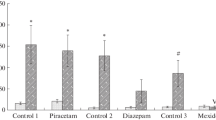Abstract
We compared the effects of haloperidol and amphetamine on the conditioning of the avoidance reaction in rats and its revesible disturbances by delivering electrical stimuli conflicting with the established relation between stimulation, responses, and their consequences. Amphetamine accelerates conditioning of avoidance reaction and diminishes the impact of functional disturbances. Haloperidol in a dose of 0.1 mg/kg completely inhibits avoidance but not intersignal reactions; in animals injected with 0.01 mg/kg haloperidol, avaidance reactions can be conditioned but less effective than in control animals. Functional disturbances inhibit avoidance and increase the number of intersignal reactions. These findings suggest that haloperidol in low doses activates generalized motor activity and does not improve adaptive reactions timed with conditioning stimulus and ensuring escape from electrical footshock.
Similar content being viewed by others
References
Yu. A. Aleksandrovskii,Heloperidol in the Treatment of Schizophrenia. Author's Abstract of PhD Thesis, Moscow (1965).
P. K. Anokhin,Biology and Neurophysiology of Conditioned Reflex [in Russian], Moscow (1968).
B. B. Borisyul and V. I. Kresyun, in:Pharmacology of Nootropic Agents. Experimental and Clinical Studies [in Russian], Moscow (1989), pp. 8–19.
A. N. Inozemtsev, S. B. Bokieva, T. A. Voronina, and N. A. Tushmalova,Byull. Eksp. Biol. Med.,122, No. 8, 152–155 (1996).
A. N. Inozemsev and L. L. Pragina,Zh. Vyssh. Nervn. Deyat.,39, No. 4, 764–766 (1989).
A. N. Inozemtsev, L. L. Pragina, F. A. Firova, et al.,Farmakol. Toksikol.,58, No. 3, 15–16 (1995).
V. B. Kennon,Physiology of Emotions [in Russian], Leningrad (1927)
G. M. Molodavkin,Byull. Eksp. Biol. Med.,91, No. 1, 48–50 (1981).
P. V. Simonov,Emotional Brain [in Russian], Moscow (1981).
K. V. Sudakov, in:System Behavioral Mechanisms [in Russian], Moscow (1990), pp. 9–38.
S. Tuneva, Ts. Tencheva, N. Tyutyulkova, and M. Nikolova,Med. Biol. Information, No. 6, 8–11 (1980).
N. A. Tushmalova, N. G. Bezlepkin, F. F. Kokaeva, and A. I. Gaziev,Dokl. Acad. Nauk SSSR,320, No. 9, 761–763 (1991).
O. Benesova, N. Dloholkova, A. Pavlik,Acta. Nerv. Super. (Praha),27, No. 4, 284–285 (1985).
V. J. Nikolson and O. L. Wolthuis,Brain Res.,113, 616–619 (1976).
J. P. Pede, L. Schimpfessel, R. Crocoett,Arch. Int. Physiol. Biochim.,79, No. 5, 1036–1037 (1971).
Author information
Authors and Affiliations
Additional information
Translated fromByulleten' Eksperimental'noi Biologii i Meditsiny, Vol. 125, No. 1, pp. 56–58, January, 1998
Rights and permissions
About this article
Cite this article
Inozemtsev, A.N., Bokieva, S.B., Spinei, A.B. et al. Effect of haloperidol and amphetamine on conditioning and functional disturbances in avoidance reaction. Bull Exp Biol Med 125, 47–49 (1998). https://doi.org/10.1007/BF02496799
Received:
Issue Date:
DOI: https://doi.org/10.1007/BF02496799



